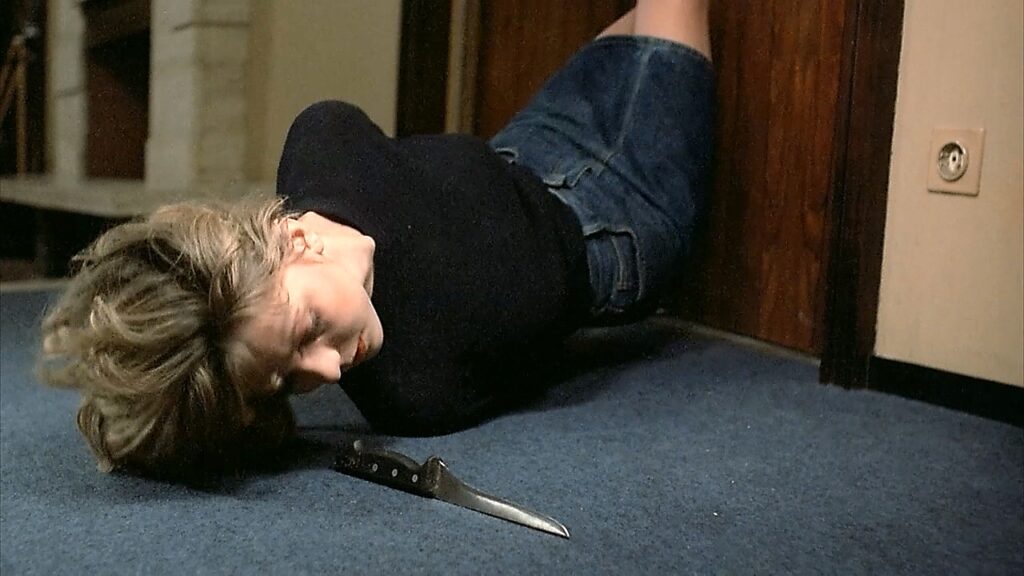
Angst (1983) is a largely fictionalized dramatization of Werner Kniesek’s mass murders in St. Pölten, Austria, during the early winter of 1980. The film is a collaboration between director Gerald Kargl and cinematographer/editor Zbigniew Rybczyński. In writing Angst, Kargl and Rybczyński re-imagine the thriller as a piece of subjective interiority. This interiority exists abstractly; limited to the soundtrack of the film which, with but a few exceptions, is composed exclusively of the psychopath’s (Erwin Leder) inner monologue (rendered in voiceover) and Klaus Schulze’s avant-garde synth compositions.
Much of the tension in Angst is derived from this juxtaposition of subjectivity (sound) and objectivity (image). What is seen is often at odds with what is heard in the killer’s voiceover. The two are melded together thematically, linked by their explicit violence. As the killer tortures an elderly woman (Edith Rosset) on screen his voiceover recalls the many ways he himself was brutalized by his own mother. It is in this way that Angst immerses the spectator in the killer’s world; a world of violence, degradation and sexual frustration. It is a highly affective tactic on the part of Kargl and Rybczyński whose methodology disposes of rather than subverts genre expectations.
Typically in these kinds of thrillers the antagonist’s interior world, even when they are the central character of a film, is only glimpsed by the viewer. In Psycho (1960) Norman Bates’ subjective reality is suggested and discussed but only a handful of minutes during the film are devoted to placing the audience in his world. Angst does the opposite of this by forcing the viewer to live with the killer in the most intimate space that the cinema can create. Just like the slain family the audience is trapped and in a sense victimized by this psychotic murderer. Kargl and Rybczyński expect the viewer to reckon with the murderer’s motives and actions simultaneously and in real time.
Rybczyński’s visual agenda for Angst is comprised of two opposing impulses. On the one hand, such as when the killer flees through the woods or gets in a traffic accident, the camera adopts a cinéma vérité approach which grounds the action in a quasi-realist context as suggested by such a methodology. It is important to note that these moments deviate from the visual complex of the majority of the film and work as a kind of punctuation for those instances when the outside world or “reality” intrudes on the killer’s internal reveries. The bulk of Angst is photographed in a more expressionist style that utilizes high angled shots and cranes to create a distorted sense of space in the house of the victims. The look Rybczyński achieves is reminiscent of Vittorio Storaro’s work in Il conformista (1970) though Rybczyński’s aim is to reflect the killer’s subjective experience of an unknown space rather than to lose an assassin in his historical context.
Angst, designed as a full frontal assault on the viewer, has an intriguing kinship with the early films of Richard Kern, Lydia Lunch, and Nick Zedd. In the eighties shock tactics were the preferred method to startle viewers out of their complacency. However, unlike its distant relatives in the Transgressive Cinema movement, Angst isn’t so much an extension of Punk aesthetics as it is a perversion of art house aesthetics. As is the case with Brian De Palma, Kargl and Rybczyński are interested in bringing high art to the exploitation film. That is to say that by treating what would on paper be an exploitation film as something serious and artful the filmmakers are able to realize the full potential of such narratives thoughtfully if not transcendentally.
To this day Angst is still the most engaging and disturbing film about murder ever made. Part of that is due to the simplicity of its plot. What Kargl and Rybczyński reveal to the audience is only what matters to the killer. A more detailed context regarding the killer’s parole or experiences in prison would only obscure the image of the murderer and reduce Angst to something much more commonplace. As it is, Angst is a harrowing experience and an unflinching look into the eyes of the cruelest aspects of human nature.
